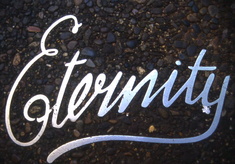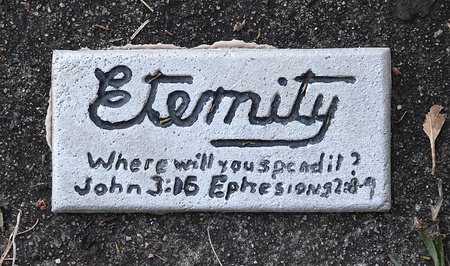
All About Mr. Eternity
First published: Tuesday June 15th, 2021
Report this blog
Arthur's Early Years
On the 9th of February, 1885, in the suburb of Redfern, Sydney NSW, William and Laura Stace welcomed there fifth child Arthur Malcolm Stace into the world.
With alcoholic parents, Arthur was born into a poor family. In order to survive he started stealing bread and milk and searching for food scrapes in rubbish bins.
By the age of 12, Stace, with virtually no formal schooling, and working in a coal mine, had become a "ward of the state". As a teenager he became an alcoholic, due to the example of his parents, and at the age of 15 he was sent to jail.
In March, 1916 at the age of 32 he enlisted for "World War I" with the 19th Battalion 5th Brigade AIF. He suffered recurring bouts of bronchitis and pleurisy which led to his medical discharge on 2 April, 1919.
His Conversion to Christianity
Arthur became a Christian one night on the 6th of August, 1930, after hearing the Gospel preached by Reverend Robert B. S. Hammond. Amazed and inspired by the words he heard, he became enamoured with "Eternity". Two years later, on 14th of November, 1932, Arthur was further inspired by the preaching of evangelist John G. Ridley, who was preaching on "The Echoes of Eternity" from Isaiah 57:15
For thus saith the high and lofty One that inhabiteth eternity, whose name is Holy; I dwell in the high and holy place, with him also that is of a contrite and humble spirit, to revive the spirit of the humble, and to revive the heart of the contrite ones.
Reverend John Ridley's words, "Eternity, Eternity, I wish that I could sound or shout that word to everyone in the streets of Sydney. You've got to meet it, where will you spend Eternity?" proved crucial in Stace's decision to tell others about his faith.
Several mornings a week for the next 35 years, Stace woke at 4am to go around the streets of Sydney and chalk the word "Eternity" on footpaths, doorsteps railway station entrances, and anywhere else he could think of. Workers arriving in the city would see the word freshly written, but not the writer, and "The man who writes Eternity" became a legend in Sydney. The Sydney City Council brought him to the attention of the police as they had rules about the defacing of pavements, so much so that he narrowly avoided arrest about twenty-four times. Each time he was caught, he responded with, "But I had permission from a higher source". After eight or nine years, he tried to write something else, "Obey God" and then five years later, "God or Sin" but he could not bring himself to stop writing the word "Eternity".
It is estimated that he wrote the word "Eternity" over half a million times over the 35 years!!

After a period of homelessness, Stace found work as a caretaker and cleaner at the city offices of the Australian Red Cross and his local church, Burton Street Baptist Tabernacle. He also volunteered for decades as a social worker, assisting the unemployed, addicted, and mentally ill, both through his work for Anglican minister Robert Brodribb Hammond, and later of his own volition. In 1942, at the age of 57, Stace married Ellen Esther "Pearl" Dawson.
The Eternity Script
The National Museum of Australia in Canberra holds one of only two existing original 'Eternity' inscriptions by Stace. He chalked it on a piece of cardboard for a fellow parishioner. The museum also has an Eternity gallery, inspired by Stace's story. The gallery features 50 personal stories from ordinary and extraordinary Australians. Each individual feature tells a separate story, anchored by a significant object. The stories are tied together by emotional themes including joy, hope, passion, mystery, thrill, loneliness, fear, devotion, separation and chance, which are all elements of Stace's story.
In Sydney the word "Eternity" can be seen written in a few places, of which only one is original:
Inside the bell in the Sydney General Post Office clock tower, which had been dismantled during World War II. When the clock tower was rebuilt in the 1960s, the bell was brought out of storage and as the workmen were installing it they noticed, inside, the word "Eternity" in Stace's chalk. This is the only surviving "Eternity" by Stace's own hand in Sydney. How Stace had been able to get to the bell, which had been sealed up, remains unclear.
On Stace's grave in Botany Cemetery. Eternity Café (In Town Hall Square between St Andrew's Cathedral and the Sydney Town Hall) was named after Stace's one word sermon. When the area was redeveloped in the 1970s, a wrought aluminium replica of the word in Stace's original copperplate handwriting was embedded in the footpath near a waterfall as a memorial to Stace.
The Eternity Playhouse, a theatre named in Stace's honour, at Darlinghurst, the former Burton Street Tabernacle.
Above the entrance to the Eternity Café in Central Railway Station, Sydney which was also named in his honour.
His Death
After his wife Pearl died in 1961, Stace left the Sydney suburb of Pyrmont in 1965 and moved to a nursing home in Hammondville in Sydney's south, where he died of a stroke on the 30 July 1967 at the age of 82. He bequeathed his body to the University of Sydney; subsequently, his remains were buried with those of his wife at Botany Cemetery in the Eastern Suburbs Memorial Park about two years later.

His Legacy
After Stace's death, the NSW government moved to permit the use of chalk on all public pavements in the state, passing a law known colloquially as 'Arthur's Law'.
The heritage-listed Burton Street Tabernacle was restored by the City of Sydney and transformed into a theatre. It was named the Eternity Playhouse on 5 December 2011 in tribute to Arthur Stace. His famous "Eternity" script is replicated on the marquee and throughout the theatre.
As a tribute to the man known as Mr Eternity, the Sydney Harbour Bridge was lit up with the word "Eternity" as part of the celebrations for the beginning of the year 2000 Sydney New year's Eve celebrations, as well as part of the Sydney 2000 Olympic Games Opening, at the celebration of the XXVII Olympiad.
A screen print homage of Stace's copperplate "Eternity" was made by Martin Sharp in 1990, now at the National gallery of Australia.
"The Eternity Man" is an opera based on Stace's life, written by the Australian composer Jonathan Mills to a libretto by Dorothy Porter. This was adapted in 2008 into a film directed by Julien Temple.
Ending
As we can see from this blog, Mr. Eternity was a pretty amazing man, with an amazing story!
I hope everybody that read this blog learnt a lot, and enjoyed it! And thanks for reading!
